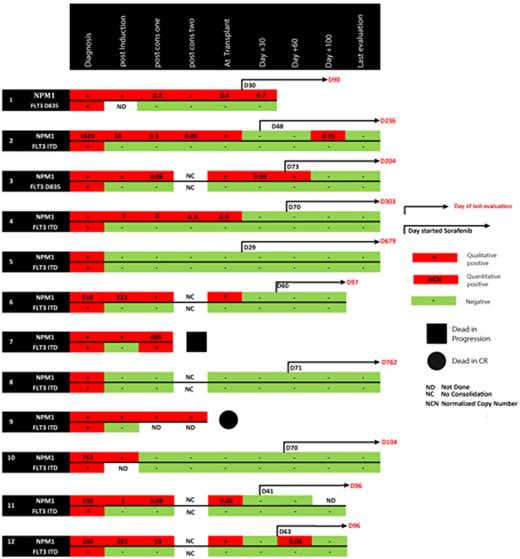Abstract
BACKGROUND: Concomitant NPM1 and FLT3 mutation occurs in 20% of AML patients. Molecular response and achievement of negative minimal residual disease (MRD) are strong predictors of long-term outcome. However, little is known about the dynamics of molecular response in NPM-1 and FLT-3 double positive mutations.
OBJECTIVE: To assess the dynamics of molecular response to treatment in AML adult patients with concomitant FLT3 and NPM1 mutations.
DESIGN: Retrospective single center study.
SETTING: This study was approved by the institutional review board of American University of Beirut Medical Center.
PATIENTS OR OTHER PARTICIPANTS:
Twelve consecutive newly diagnosed (n=11) or relapsed (n=1) AML patientsreceived Idarubicin/cytarabineinduction and one or two consolidation(s) (Table 1). Ten patients received allogeneic stem cell transplant (allo-SCT) followed by post-transplantsorafenibmaintenance. Median follow-up was 11.5 (6-27) months. All transplanted patients remain alive and disease free.
INTERVENTIONS: FLT3 mutation was tested on DNA using a qualitative method with a sensitivity of0.01%. NPM-1 mutation was tested on cDNA using a qualitative or a quantitative RT-PCR with a sensitivity of 0.01% and0.008 NCN respectively. Patients were tested at diagnosis, after induction, after each consolidation, before and at days 30, 60 and 100 afterallo-SCT.
MAIN OUTCOMES MEASURES: Kinetics of NPM1 and FLT3 molecular response.
RESULTS:
After induction, FLT3 became negative in all tested patients (n=10). After first consolidation, FLT-3 remained or became positive in 10/11 tested patients whereas a molecular relapse was noted in one patient who developed a hematological relapse and rapidly died. No molecular positivity for FLT-3 was noted later on, whether after second consolidation or post-transplant. Conversely, NPM-1 mutation became negative in 2 out of 12 tested patients after induction, in 1 additional patient after first consolidation and in 6 additional patients afterallo-SCT, mostly after startingsorafenib. NPM-1 MRD value remained elevated in 3 out of 4 patients with quantitative assessment at diagnosis and post induction.
CONCLUSION: FLT3 become negative early after induction while NPM1 negativity lags behind. Persistent NPM-1 MRD does not seem to predict post-transplant outcome and may indeed become negative after sorafenib. These results need confirmation in larger studies.
No relevant conflicts of interest to declare.
Author notes
Asterisk with author names denotes non-ASH members.



